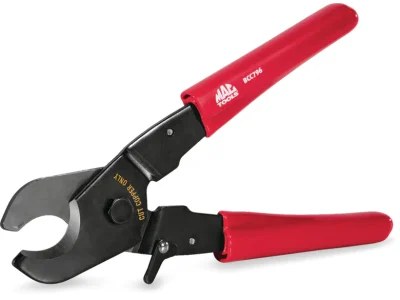Project Report For Cable Cutter
Introduction
Project Report for Cable Cutter is as follows.
Cable cutters are a common tool used in many industries in India. They are designed to cut through a variety of cables and wires, such as electrical wires, coaxial cables, and steel cables. Cable cutters come in a range of sizes and designs, from handheld cutters to larger hydraulic cutters.
Tools called wire and cable cutters are made to properly cut wire or cable while causing the least amount of harm to the insulation or internal conductors of the wire or cable. The quality of an electrical connection can be enhanced by a clean cut on a wire or cable. You run the danger of harming the insulation, which could jeopardise the integrity of the wire or cable, without the correct tools. In addition, you run the risk of damaging the connection’s interior conductors, which could have a negative impact on the connection’s conductivity.
Electrical wire and cable must be cut cleanly without damaging the insulation or conductors, which is why Pacer wire and cable cutters are used in these situations. They are ideal for usage during new installations, equipment replacement, and maintenance. For on-the-spot repairs, many boaters maintain a set of wire and cable cutters on their vessel. These are the ideal solutions for you if your cable cutters are broken or worn out. These devices are compatible with both Pacer multiconductor and signal cable as well as Pacer wire and cable.

We can divide our wire and cable cutters into two categories: manual operation and ratcheting action. These categories stand apart from one another and each offers unique benefits. Manual cutters are easy to use with one hand and allow single stroke cutting of wire and cable. Thicker cables that would be challenging to cut with a manual operation cutter can be sliced through with ratcheting action wire and cable cutters. Choosing how frequently you will use this instrument and what gauge of wire you will frequently cut is the best course of action. Making ensuring you have the right tool is crucial because operator fatigue can cause production times to go down.
One of the many advantages of a ratcheting cable cutter is reduced operator fatigue. When using a manual operation cutter to manually cut a large quantity of wires and cables, operator fatigue is unavoidable. Ratcheting cable cutters prevent this risk by moving the user’s hands’ strain to the cutter itself. A ratcheting cable cutter promises a cleaner cut because it can cut through 4/0 AWG cable without needing to be adjusted. It would most likely take numerous attempts with a hand tool to cut through a cable that thick, destroying the insulation and internal conductors in the process.
Get Completely Custom Bankable Project Report
Market Potential for Cable Cutter
The market for Wire and Cable Cutter was valued at USD 169.27 billion in 2019; it is anticipated to increase to USD 237.06 billion by 2027, expanding at a compound yearly growth rate (CAGR) of 4.3% from 2020 to 2027.
The main driver of market growth is the accelerated expansion of the building infrastructure along with the rise in urbanisation. This has affected how much energy and power are needed overall in the commercial, residential, and industrial sectors. The demand for wires and cables is also anticipated to expand in the upcoming years due to increased investment in the upgrading of the power distribution and transmission infrastructure as well as smart city projects.
One of the products that has been gaining popularity in recent years is the cable cutter. A cable cutter is a tool used to cut cables of different thicknesses and materials, including steel, aluminum, copper, and more.
The market potential of cable cutters in India is significant for a number of reasons. First and foremost, the country’s infrastructure is rapidly expanding, with new buildings, bridges, and highways being constructed every year. This means that there is a high demand for cables and wires of all types, and therefore a need for tools to cut them.

